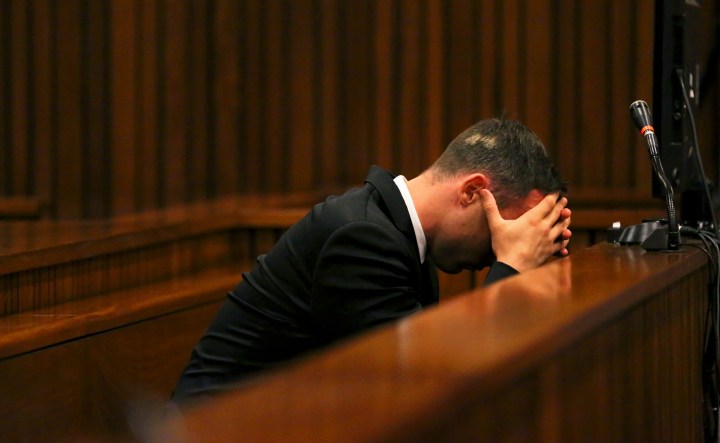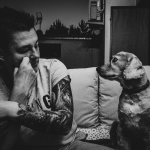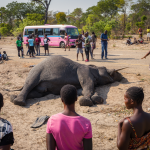Maverick Life
Pistorius Trial Week Three: Day Three

It's another sunny morning in Pretoria this Tuesday. But though the weather may be similar to yesterday, many of us are hoping that the trial's evidence will be slightly different. Police photographer Bennie van Staden's tour of his crime-scene albums proved a little wearying by Monday's end. But it's good for us to remember that this isn't sport, or theatre. The wheels of justice sometimes grind slowly, and REBECCA DAVIS will be trying to stay awake.
09.00 Morning from the North Gauteng High Court. The defence’s Barry Roux appears to be in fine fettle, laughing and cracking jokes with his team, which should probably make witnesses feel uneasy. The ANC Women’s League’s dedicated contingent have taken up their seats early, on the Steenkamp side of the bench as ever.
Reeva Steenkamp’s mother June, who didn’t last long in court yesterday after the crime scene photos came out, is back today. She’s supported by Reeva’s cousin Kim Martin and her husband. The Pistorius family is continuing their attempts to reach out. This morning it was Oscar’s Uncle Arnold who was dispatched to the Steenkamp ranks to say a few words, though he didn’t seem to meet with a particularly warm reception from June Steenkamp.
The most interesting revelations out of yesterday’s court session were firearms trainer Sean Rens’s testimony that Pistorius was well versed in what constituted an unlawful shooting; and the still mysterious evidence that there may have been blood smatters behind Pistorius’s bed. Let’s see if this latter point in particular gets picked up on again today.
13.00 There was an extremely delayed start to today’s proceedings, and when things did kick off, they’ve been moving at a glacial pace.
We waited in courtroom GD from our allocated start time at 09.30 until 11.00, without much idea of what was going on. It was subsequently explained that police photographer Bennie van Staden was still organising the master copies of the crime scene photographs requested by Barry Roux, over the course of 60 CDs. Van Staden also explained that he had to ask permission from his superiors to bring them to court.
Roux’s game again has been to cast doubt on the reliability and professionalism of the police’s handling of the crime scene. The lawyer showed van Staden two examples of sets of photos in which the pictured objects appeared to have moved around. In the first case, the angle of the cricket bat used to bash in the toilet door, lying blood-smeared on the floor, has changed between two photos. Van Staden acknowledge that someone must have moved it. Similarly, two photos of Pistorius’s gun lying on a mat showed that the position of the map had shifted between the two.
Van Staden claims that he was alone while photographing Pistorius’s bathroom and bedroom. “When you took the photos, are you sure you were alone up there?” Roux asked, which van Staden confirmed. But Roux has been using the metadata on photographs taken by van Staden’s colleague (and superior) Colonel Motha to make the case that the timing of the photographs proves that the two men were operating simultaneously.
The timings even suggest that the two men may have been taking photographs in the same bathroom, at the same time. Van Staden’s denial led Roux to ask caustically how big the bathroom was. Roux also showed van Staden a photo taken by van Staden himself, outside the Pistorius house looking up to the bathroom window. In that photo, the head of a man is indistinctly visible – proving that a police member must have been in the bathroom at this time.
Journalists and members of the public have been asking whether it’s not possible that the time stamps between Motha’s camera and van Staden’s camera might be different – giving the illusion that they were in the same place at the same time when in fact they weren’t. If there’s any merit in this, no doubt the state’s Gerrie Nel will take it up again when he comes to re-question the witness.
Roux also claimed that in police photos, sandals pictured by the side of Pistorius’s bed change positions at least four times. Van Staden claimed ignorance as to who had moved them, but did concede to having moved a gym bag. (In an interesting article about the job of police crime-scene photographers yesterday, forensic expert David Klatzow stressed that police photographers should do their best not to move any scene elements.)
One intriguing aspect of this morning’s evidence touched on fleetingly was a picture of the main door to Pistorius’s bedroom, which has been revealed to have suffered some damage itself. This may be old, or unrelated to the crime: it hasn’t yet been explained. eNCA journalist Karyn Maughan tweeted her understanding that a hole in the door was caused a while ago by the air rifle propped up against the door. We haven’t heard anything specific about it yet – though if Maughan’s right, it does suggest a further record of reckless gun-handling.
15.30 Anyone concerned about the very short court day can take comfort in the fact that Judge Masipa took 25 minutes off the lunch break to make up for the delays this morning, and we finished half an hour later than usual. So that’s something.
We’ve been referring to van Staden’s colleague on the scene up to now as a Colonel “Motha”, but it emerges his surname is “Motwa”. Apologies for that. When we resumed after lunch, Roux was still banging on at van Staden about whether he was truly alone when photographing the crime scene. Roux displayed a photo of the black iPhone found in the bathroom, which was taken by van Staden at 06.18am. He then showed van Staden another view of the iPhone, lying amidst towels and Pistorius’s weapon, taken by Motwa at 06.03am.
Van Staden acknowledged that there was nothing to suggest that the time-stamps on the two cameras’ metadata was incorrect, which would seem to remove that avenue as a possibility for Nel to pursue.
Roux was also interested in the photographs which van Staden had taken of forensic expert Colonel Vermeulen – who testified last week – carrying out tests to see the angle at which the cricket bat would most likely have struck the toilet door, when wielded by Pistorius. Roux said that defence ballistics experts had pointed out that there was a mark nearer the top of the door which could have been made by Pistorius’s bat if the athlete was wearing his prosthesis. But the only photos included in the police’s album showed Vermeulen swinging the bat to replicate Pistorius’s stance on his stumps.
Van Staden denied Roux’s implication that Vermeulen had specifically instructed him to include only photos in the album which bolstered the state’s version – Pistorius on stumps – of events. He said that Vermeulen had not explicitly told him which photos to put in and leave out: he had merely consulted with van Staden as to the photos he found most important.
Nel, in re-examination of van Staden, sought to counter Roux’s suggestion that Motwa and van Staden must have encountered each other in taking their respective photos of the scene. Under Nel’s questioning, van Staden indicated that Colonal Motwa was not present in any of his photos, and that the two did not have an agreement not to appear in each other’s photos. He also denied having moved anything on the scene when initially photographing it on the morning of 14th February.
Nel also disputed Roux’s assertion that two photographs of the bloodied cricket bat lying on the floor showed that the bat had been moved. Pointing out a fold in the bat’s handle which was consistent in both, and a drop of blood which remained similarly placed, he suggested that what had changed was the angle of the camera. As such, the idea that the bat had moved was an optical illusion. “Let’s give Mr Roux the benefit of all doubt,” Nel said. “If the bat moved, it only moved millimetres.” Van Staden agreed.
With a final bite at the apple, Roux pulled up one last photo for van Staden to consider, taken by Motwa, which showed a photo of a gloved hand pointing through the bathroom window. Roux asked van Staden to concede that Motwa must not have been alone in the bathroom when he took this photo. Van Staden conceded as much.
“I’m instructed that when you’re taking photos of the scene you shouldn’t see any other people,” Roux delivered as a parting shot at van Staden’s crime scene technique. Van Staden responded that he concentrated on the scene at hand.
With van Staden disposed with, Nel put in a plea to Judge Masipa to adjourn early for the day because of the technical nature of the evidence to be given by the next witness, which he said he would prefer to deal with in the course of one uninterrupted session. Masipa, clearly conscious of the perception of court time, refused. As such, Captain Christian Mangena, a ballistics expert of 19 years’ standing, was sworn in.
The job of the ballistics expert is essentially to determine the angle and distance of the shots fired. Mangena spent much of his time on the stand referring to photographs which the public gallery (and media) were not shown, out of consideration to Steenkamp’s family present. He said that in order to reconstruct the trajectory of the bullets that struck Steenkamp, he used both a steel rod and a laser – the latter to shine through the door’s bullet holes to work out if, how and where the bullets hit the wall behind.
Only one bullet hit the wall, it emerged, which must have been the shot which missed Steenkamp. (The reason we can guess this is because of the nature of the Black Talon ammunition which Pistorius was using, which doesn’t generally ricochet beyond its target because it expands upon contact with tissue.) Mangena, who’ll be back on the stand tomorrow morning, concluded by giving Pistorius’s various height measurements when wearing his prosthetic legs, and when without.
Again, in summary, a dry day at the Pistorius trial. The defence continues to try to make the case that the police work at the crime scene and afterwards has been shoddy, and potentially compromising. The state continues to call expert after expert who are not Hilton Botha in the hope of mitigating this perception. Pistoriuses and Steenkamps alike look tired and strained. It’s a grim business. DM
Photo by Reuters.

















 Become an Insider
Become an Insider